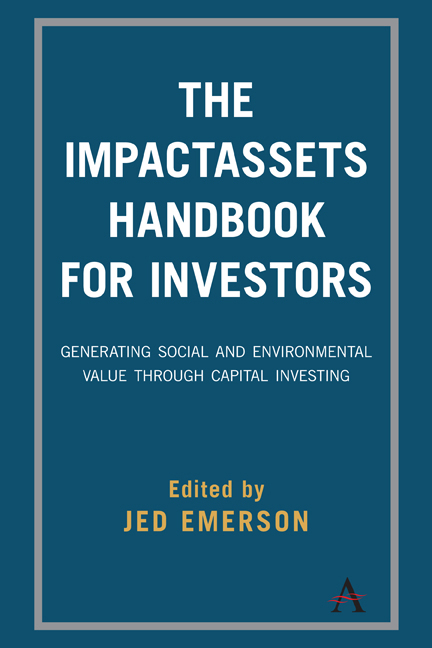 The ImpactAssets Handbook for Investors
The ImpactAssets Handbook for Investors Book contents
- Frontmatter
- Dedication
- Contents
- List of Contributors
- Preface
- Introduction
- 1 Construction of an Impact Portfolio: Total Portfolio Management for Multiple Returns
- 2 Total Portfolio Management: One Practitioner's Approach
- Case Study 1
- Case Study 2
- Case Study 3
- 8 The Measurement Challenge
- Case Study 4
- Appendix: Impact Investing Resources
- Notes on Contributors
- Index
Introduction
Published online by Cambridge University Press: 15 October 2019
- Frontmatter
- Dedication
- Contents
- List of Contributors
- Preface
- Introduction
- 1 Construction of an Impact Portfolio: Total Portfolio Management for Multiple Returns
- 2 Total Portfolio Management: One Practitioner's Approach
- Case Study 1
- Case Study 2
- Case Study 3
- 8 The Measurement Challenge
- Case Study 4
- Appendix: Impact Investing Resources
- Notes on Contributors
- Index
Summary
Your picking up this book is a reflection of the fact that while we all may acknowledge many of the incredible, positive effects finance and capital have had upon our world—lifting millions out of poverty, bringing electricity (increasingly solar generated) into formerly dark places and improving housing options for great numbers of people—the reality is many of our planet's most critical challenges remain. Accessible primary health care and secondary education are beyond reach for many, affordable housing is an issue in both developed and developing nations and the diverse effects of climate change are now making their presence felt around the globe. These are not issues government or nonprofits can address alone. While the role of philanthropy and public funding will continue to be key, the reality is you cannot donate your way out of poverty or back to a green planet. There is a direct and meaningful role to be played by business in working with other sectors to drive positive change in our world. And whether we're talking about mission-driven for-profits or nonprofit social enterprise, the fuel of business is capital.
Traditional, mainstream investing has been built on the belief that investing and consideration of social or environmental issues are two distinct worlds—and that if you include considerations of social or environmental factors within your investing, you will underperform financially. The reality is investing currently creates impacts—both negative and positive—in our world. But today we have the opportunity for investors, both large and small, to work to minimize negative impacts and optimize positive ones through the intentional and strategic deployment of their capital. And in recent years investment strategies that seek to generate various levels of financial return as well as the creation of positive social and environmental impacts have come together under the broad banner of impact investing.
This process has occurred because we now know that not only may we invest to create a better world, but we may do this and at the same time provide for ourselves, our families and our community. We can be financially responsible and advance a more just, sustainable planet.
- Type
- Chapter
- Information
- The ImpactAssets Handbook for InvestorsGenerating Social and Environmental Value through Capital Investing, pp. 1 - 20Publisher: Anthem PressPrint publication year: 2017


